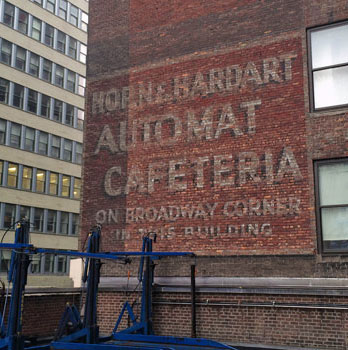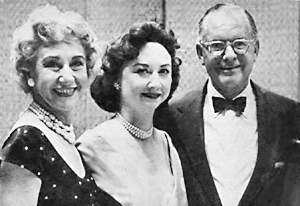Here are 10 things you should know about Anne Shirley, born 103 years ago today. She made more than 65 movies before retiring at age 26.
Tag: Manhattan
10 Things You Should Know About James Burke
Here are 10 things you should know about James Burke, born 134 years ago today. The prolific character actor may have played more cops on the silver screen than anyone in movie history.
A Journey Back to Old New York
A couple of years back, The Museum of Modern Art performed a digital restoration on some travelogue footage of New York City that was shot in 1911. They did a great job with it, and the video was widely disseminated—you may have seen it at the time or in the months since.
Now, a Swedish company called Svenska Biografteatern has done even more work on the footage, giving it a higher frame rate and resolution (4K) and a subtle color tinting.
For anyone who loves New York (or dreams of time travel), it makes for a magical eight-minute journey into the past.
Echoes of the Automat
There’s an oft-quoted passage from a Joan Didion essay entitled Goodbye To All That that reads, “I still believed in possibilities then, still had the sense, so peculiar to New York, that something extraordinary would happen any minute, any day, any month.”
Ms. Didion may have stopped feeling that way about New York somewhere along the way, but we haven’t. In fact, the enduring sense that something extraordinary (and/or strange, serendipitous, surprising, wonderful) could happen at any time is one of things that hooked us but good on this city more than 35 years ago and keeps us engaged with New York even today.
One can live here for 34 years (as we have) and still step out your front door and encounter something you’ve never seen before.
Our day’s tasks on a recent Saturday found us at the corner of 38th street and Eighth Avenue in Manhattan, less than a mile north of Cladrite HQ, when we spotted, to our surprised delight, a painted ad on the side of a brick office building just east of the avenue.
These hand-painted signs are sometimes called “ghost signs,” in part because they are virtually all painted many decades ago, they often advertise products and establishments that no longer exist and they are frequently only discovered—uncovered, really—when another building, built more recently, is razed, revealing the long-forgotten advert. The newer, now-demolished building had hidden (and thereby preserved) the ghost sign all those years.
That wasn’t the case with the sign we spotted on Saturday. It peeks over the roof of a four-story commercial parking garage, so while it might once have been concealed by another building, it has been, for at least as long as the parking garage has been there, hiding in plain sight.
 |
 |
That the sign was for an Automat once in operation on the building’s ground floor made all the difference. We love all these old signs and always get a kick out of spotting examples we’ve never noticed before, but an advertisement for an Automat? For our money, it gets no better than that.
Number, Please

|
| (r to l) Arlene Francis, Dorothy Kilgallen, Bennett Cerf (Sorry, we couldn’t find Kilgallen’s address or phone number) |
There are three types of vintage publications we can’t resist giving at least a quick browse: retail catalogues, school yearbooks, and telephone directories.
So we were delighted to learn that the good folks at the New York Public Library, bless their hearts, recently posted the 1940 phone books for each of the five boroughs of New York.
If you grew up in NYC or your parents or grandparents did, you’ll have fun tracking them down, but even if, like us, you have no connection to NYC that dates back seventy-plus years or, heck, no family connection whatsoever to the Big Apple, this is still a resource you can enjoy, if only for the joy of perusing the telephone exchanges.
We’ll compose a post one day about our affection for these magical words, but today suffice it to say that telephone numbers that begin not with mere digits but with melodic vocables such as Trafalgar, Whitehall, Butterfield, and Bogardus evoke bygone eras like few other verbal artifacts can.
Then there are the advertisements. We don’t know whether there were yellow pages-style business directories for New York City in those days, but these white pages include plenty of ads: Tyson Sullivan theatrical ticket service, Underwood Typewriters, American Pencil Company, Elfinbein’s Baking Corporation: Bakers of Cakes, Pastries and Pies Since 1918.
Then there’s the celebrity spotting. You might have known that artist Edward Hopper lived and worked at 3 Washington Square—that info’s relatively common knowledge—but did you know his phone number was SPring 7-0949?
We’re tempted to punch in those seven digits; we’re willing to bet the current holder has no idea that America’s greatest painter (in our humble opinion) once took calls at that number.
Then there’s What’s My Line? doyenne Arlene Francis. In 1940, she was a working actress, having appeared in eight Broadway shows and a movie or two. She was married to one Neil Agnew, who worked in the sales department for Paramount Pictures, and they lived at 320 Park Avenue. Their phone number was WIckersham 2-9486. They had separate listings in the phone book, which was probably a good thing, as they were to be divorced just five years later.
Arlene lived just a short stroll away from Bennett Cerf, who would be her fellow What’s My Line? panelist and in 1940 was already the publisher behind Random House. Cerf’s phone number was PLaza 3-0230, and he lived at 20 East 57th Street, just six blocks away from Francis. One wonders if they were yet acquainted in 1940.
